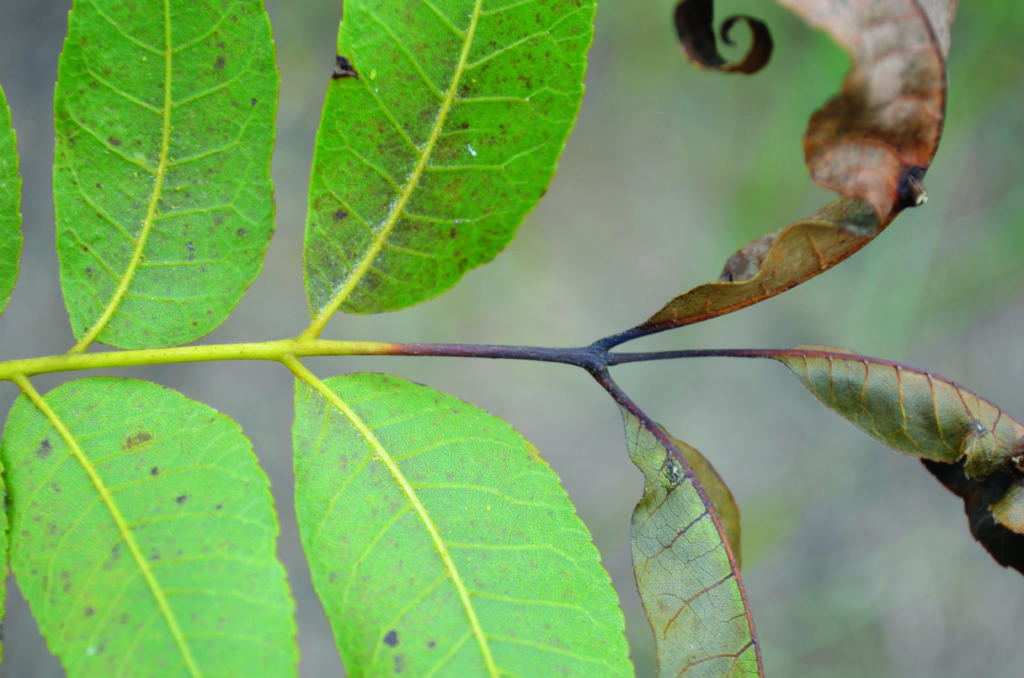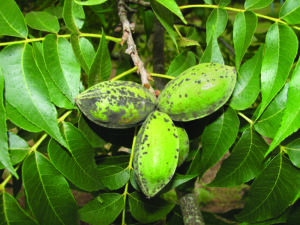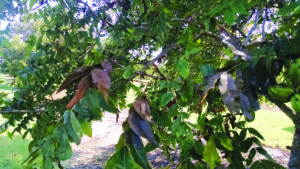
July/Aug 2022
3 disease threats in Texas pecan
Disease pressures can vary from season to season and are dependent on a number of factors, especially humidity and heat stress. But there are three that are taking the lead in posing particular risk for pecan growers in Texas, as well as in other states.
Scab
An infection caused by a fungal pathogen, pecan scab is the primary disease to watch out for in pecan crops. Though there are varieties that are more susceptible than others, it remains a top concern.

“It’s hands down of the greatest economic importance to the pecan industry,” said Monte Nebitt, Extension program specialist at Texas A&M University’s Department of Horticultural Sciences.
The climate must be warm enough and wet enough for pecan scab to take hold. While wildfires and burn bans can mean havoc for other agriculture industries, they’re actually favorable for pecan growers because they indicate the land is very dry.
2021 had abnormally high rates of scab, but 2022 hasn’t yet seen much of a problem.
“The more rainy days an orchard experiences, the greater potential there is for damage,” said Nesbitt. “Scab is of enough economic importance that it requires certain control efforts.”
University of Georgia (UGA) is currently the best source of recommendations for scab control. According to the 2022 Spray Guide published by UGA Extension, orchards with any amount of scab by mid-June should adopt rigorous control efforts, including shortening the interval between fungicide sprays to 14, 10 or seven days based on the kind of growth identified on the plants and the weather conditions in the orchards. At the start of August, Extension recommends that growers monitor for shell hardening and adjust their spraying accordingly.
Downy spot
Downy spot appears as white spots or splotches on a pecan’s foliage and can cause premature leaf drop in the summer months.
“Leaves will drop and the tree will grow new leaves,” said Nesbitt, “but there is an interruption to carb production.”
Unlike scab, which can cause fruits to abort if the infection sets in early enough, downy spot is primarily a stress factor and can impact the quality of the nuts produced. Spot can also impact “return bloom,” therefore having year-to-year effects.
Pecan leaf dieback
Also referred to as branch dieback and twig dieback, pecan leaf dieback is a relatively new disease. Since the first case of dieback was seen in Georgia around 2014, it has been getting progressively worse. Like downy spot, dieback has the potential to affect crop quality, as well as impact growth in the following years. While the disease is caused by a known fungus – one that is also more prevalent in rainy years – there is still some uncertainty around the infection.
“I’ve observed leaf dieback disease to be a serious problem in years with wet spring and early summer conditions,” Nesbitt said. “Can it be a problem with ‘average rainfall’ in east Texas every year? I’m not certain.”

Timothy Brenneman, professor of peanut and pecan disease management at UGA’s Department of Plant Pathology, said the fungus “responds to most fungicides, and it’s much worse on some cultivars than others. Detailed epidemiology of the disease has not yet been worked out.”
In a 2014 fact sheet published by Clemson University Cooperative Extension, the authors noted that nearly any stress factor on a tree could increase the likelihood of dieback. As for identifying dieback, the first sign is often wilting branches, which on closer inspection will have small black pustules. The disease can cause branches to die back several inches and stop producing new growth.
Preventing disease
Scab, downy spot and leaf dieback are diseases caused by fungi that thrive in wet, humid climates. For Texas, the two major divisions of pecan growing are designated by the eastern and western parts of the state. It’s in the eastern division from Dallas to Beaumont, which has a similar climate to that of neighboring Louisiana, Mississippi and Alabama, where these fungal diseases are most prevalent. Westward from Dallas to El Paso, the land becomes increasingly less susceptible to disease growth. The division is due to a difference in rainfall: about 36 inches of annual rain in Dallas compared to 10 inches in El Paso.
Consistent spraying is key for growers. “If you have susceptible varieties, and you’re interested in producing a crop, and the weather is favorable, you should be applying fungicide in the pre-pollination, post-pollination, and nutgrowth period, from April to August,” said Nesbitt.
The biggest mistake growers can make is not being aware of the conditions that are conducive to these diseases. In the wetter eastern division, rainy periods – especially consecutive days of rain – create the perfect conditions for disease growth. Of course, weather and rainfall are out of anyone’s control, but with rigorous spray schedules the disease can be managed. Much of the success of the plants depends on vigilant foresight: it’s too late to take measures after seeing symptoms, as the fungicides recommended by Texas A&M and University of Georgia are best used as a preventative measure.
Dieback caused by neofusicoccum. Photo: University of Georgia







